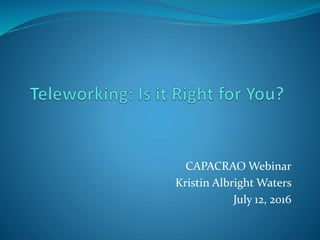
CAPACRAO Webinar 2016
- 1. CAPACRAO Webinar Kristin Albright Waters July 12, 2016
- 2. Goals of Session Become more knowledgeable about teleworking Understand pros and cons of teleworking to employee, employer, environment Learn strategies in creating Determine if it is “right for you” Answer remaining questions Session is based upon research of dissertation: The Lived Experience of Teleworking: A Case Study from the Higher Education Environment
- 3. History of Telework Jack Nilles: "Father of Telecommuting" 1974. -Teleworking: Work that is conducted away from the usual place of business but mostly at home and that is often supported by telecommunications, Internet access, or a computer. Falls under the umbrella of Flexible Work/Life Balance (FWLB). Other FWLB: shared work schedules, modified schedule, Hoteling, remote working, modified work week, Flexitour, etc. Originally designed in response to relocating to suburbs and rising oil and energy costs. Federal Government
- 5. Employer: Pros to Telework Save in expenses: water, electricity, paper, rent Supporting decrease in carbon footprint/environmental sustainability Loss production due to outside factors decreased Increased productivity: productivity studies consistently find that teleworkers outperform their peers at the traditional office by about 16 percent; which means that companies save $2 for every $1 invested in remote equipment and extra phone lines” (Hequet, 1994). Increased office space More 'favorable' to people with special needs Increased range for recruitment of employees Less vacation/sick time used for employees
- 6. Employee: Pros to Telework Saved resources: fuel, car repair, dry cleaning, etc.: "teleworking one day a week, the average commuter could save an estimated $2,104 per year" (Markarian, 2007). Increase in time Decrease in distractions at work Flexibility in the workplace Trust and Organization Commitment: "common thread in the commitment research is that when employers provide employees with a rewarding job and supportive work environment, employees reciprocate by becoming committed to the organization" (Knudsen, Johnson, Martin, & Roman, 2003). Increase in productivity; sense of deeper appreciation to the institution?
- 7. Cons to Telework Resources are needed Technology is not full proof Risk of confidential data Risk of staff not completing work Missed "water cooler" conversations Social isolation Too much productivity/Work Life Balance issues Creativity can flourish or flounder Not suited for all employees (person and position)
- 8. Research Questions RQ #1: What are the lived experiences of exempt employees who telework? Results = Chapter 4 Narratives of the lived experiences RQ #2: Do these employees experience fit as outlined by the Concept of Fit theoretical framework? Results = Chapter 5 Findings organized by the theoretical framework
- 9. Theoretical Framework: Concept of Fit DISTRIBUTED WORK ARRANGEMENTS Figure 1. A framework for studying distributed work arrangements (Belanger & Collins, 1998). Organizational Characteristics Individual Characteristics Work Characteristics Technology Characteristics FIT Outcomes Societal IndividualOrganizational
- 10. Theoretical Framework: Concept of Fit SUMMARY OF MODEL VARIABLES Organizational Characteristics Examples Organizational objectives Cost savings, increased productivity and employee demands/incentives Organizational culture Employee commitment and loyalty Organizational control mechanisms Outcome, behavioral, personal, and clan controls Individual Characteristics Examples Individual objectives Cost savings, control of work schedule Individual skills Technical and problem solving-skills, communication, reliability and self-sufficiency Work Characteristics Examples Communication pattern Base on task type: high or low information exchange requirements Coordination requirements Based on task type: standardized, scheduled, mutual agreement and team coordination Technology Characteristics Examples Security requirement Appropriate equipment and furniture, information ownership and control established Physical setup Quiet space, access to appropriate equipment and support Outcomes Examples Societal Reduced pollution, work provided in low employment areas Organizational Increased productivity, employee retention, reduced overhead Individual Increased satisfaction, control of work schedule, increased productivity, reduced commuting time and costs, stress from work-family conflicts Figure 2. Summary of model variables.
- 11. Participant Profile Demographic Characteristics of Participants Participant Gender Ethnicity Participant Code Telework Day Bertha F AA 1 Monday Laya F AA 2 Wednesday Mindi F C 3 Wednesday Paul M C 4 Tuesday Oobleck M C 5 Monday Terry F SEA 6 Wednesday Lynn F C 7 Wednesday Lucy F C 8 Friday Jim Hatfield M C 9 N/A Wendy F AA 10 Friday Anne F C 11 N/A Note. F = Female; M = Male; AA = African American; C = Caucasian; SEA = Southeast Asian.
- 12. Findings Similar experiences among participants Plan tasks to ‘save’ for telework day Distractions in the office/focus Email – first ‘thing’ they do on telework day Supportive supervisors Commute Technology: internet and computer Want to telework more Office of support Unique experiences among participants Communication with office Start and end time of telework day Personal tasks Distraction at home Technology Tasks – processing/creativity Negative thoughts/perceptions RQ #1: What are the lived experiences of exempt employees who telework? RQ #2: Do these employees experience fit as outlined by the Concept of Fit theoretical framework?
- 13. Findings, Con’t. 4 characteristics = all present Fit = participants not aware of framework 3 outcomes = all present Overall, participants experience fit as outlined by the Concept of Fit theoretical framework.
- 14. Things to keep in mind
- 15. Is it Right For You – Write it Out Concept of Fit: Organizational Characteristics Individual Characteristics Task Characteristics Technology Characteristics
- 16. How to Get Started? Review HR website for policy or benefit Ensure you have a performance review of effective Talk to your supervisor – mention to benefits to the organization FIRST, and ones that will keep you engage Offer a trial period Offer to complete all paperwork/Make is hard for them to say NO Offer a “remote location” on campus Offer 1 x month Be clear with deliverables Set clear expectations for communication
- 17. Thank you Questions? Comments? References available upon request Findings based upon dissertation research, 2016